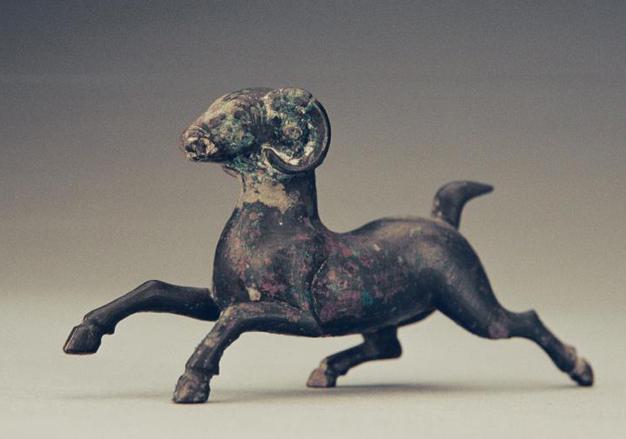Now I select a few representative articles from goat-shaped artifacts unearthed in the Central Plains to find out features of and differences in goat designs at the time.
In 1957, the gray earthenware goat-pen (Fig. 6) unearthed from Sanmenxia features two goats. They have curled horns (Fig. 14), clearly outlined mouths, noses, ears and eyes, robust limbs, plump bodies, and draping tails, and their mouths slightly open in a bleating gesture, vivid and lifelike.
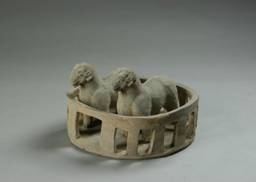
Fig. 6 Gray pottery goat-pen
In 1984, a green glazed pottery crouching goat-shaped zun vessel (Fig. 7) was unearthed from Hama Village, Xiangcheng County, Henan Province. The goat in a crouching gesture bends its four feet to the ground, and raises its head. Eyes looking straight, it slightly opens the mouth, and exposes its teeth. The two horns curl backward and form a design shaped like the letter G.
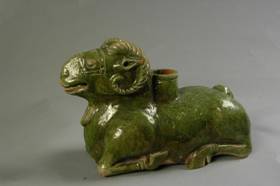
Fig. 7 Green glazed pottery crouching goat-shaped zun vessel
In April 1958, a painted pottery goat-shaped zun vessel (Fig. 8) was unearthed from an Eastern Han tomb at Hewang Reservoir, Xingyang, Henan Province. The whole article is made of terracotta. Originally it is coated in black and decorated with red patterns, but now the paint has largely peeled off. The crouching goat looks straight, and has two horns curled forward, forming a semi-circle. Its body is plump, the chest projects forward, the buttock has a short protruding tail, and the back has a trumpet-shaped tubular nozzle.
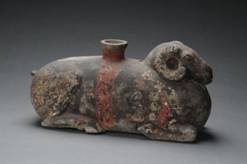
Fig. 8 Painted pottery goat-shaped zun vessel
In 1932, a bronze crouching goat-shaped lamp (Fig. 9) was unearthed from a bag-shaped tomb at Xiaozhengzhuang, Xiangcheng, Zhoukou, Henan Province. The crouching goat raises its head, its beard hangs before the chest, and two horns curl downward. The body is plump and has a hollow cavity. The goat back (the part above the tail) was turned 180 degrees upward to rest right on the head to form a lamp plate.
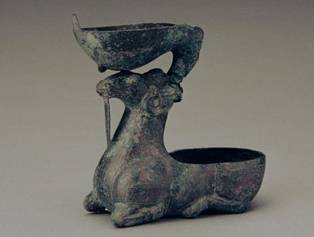
Fig. 9 Crouching goat-shaped lamp
The above-mentioned four goat-shaped artifacts unearthed in Henan all date from the Western or Eastern Han Dynasties. Standing or crouching, their shapes vary. We may draw the conclusion that the goat-shaped artifacts of the Han Dynasty, in particular, those unearthed in Henan, mostly adopt a realistic method of expression. Meanwhile, the circular carving technique is also used to make the goat head vivid and lifelike, make the whole image plump and lovely. They not only reflect the aesthetical features of auspiciousness, benevolence and grace embodied by goat in the Han culture, but also make goat a symbol of wealth and manifest the concept of elaborate funeral.
The gilded coating on the surface of the bronze galloping goat has been peeled off. Why?
There are two possibilities. Firstly, the object was not meticulously polished, and the gold poorly cohered on the surface, making it easy to peel off. Secondly, the “gold clay”, after being baked on fire, had a thin film of gold left on the object, which peeled off after abrading.
Your answer please, if you have any questions or answer, please feel free to send us email, we are waiting for your answers and participation, and your comments, answers and suggestions will be highly appreciated. We will select and publicize the most appropriate answers and comments some time in the future.
Weekly Selection Email: meizhouyipin@chnmus.net
The term gilding refers to the technique for decorating metallic surfaces invented by ancient Chinese people in the long time of production. It has a history of more than 2,000 years, and China is the earliest country to adopt this technique in the world.
Gilding is also known as liujin, dujin, huodujin or gongdujin in Chinese. It is made in this way: melt gold leaves into mercury at a temperature of about 400℃, and make the mixture into silver-colored amalgam paste, commonly called jinni, literally “gold clay”; apply the gold clay on the metallic surface, bake it on fire to volatilize the mercury, leaving a film of gold on the surface whose color will turn from silver into yellow. The process can be repeated if a thicker gilded coating is needed. The technique is only applicable to silver and copper objects as well as bronzes containing less than 20% of tin and lead. Such technique has been found on large bronzes, and techniques of gold-plating, silver-plating and gold-and-silver-plating were often adopted on the same object.
The making of gilded objects appeared relatively late in Chinese history of metallurgy. Scholars universally think that it was invented in the Warring States Period. Available archaeological findings reveal that the gilded bronze and silver objects of the Warring States Period are limited in number and scattered in many places. They have been found in Shandong, Shanxi, Shaanxi, Henan, Hunan and Zhejiang, and feature a high concentration only in areas centering on Luoyang in Henan. These unearthed artifacts prove that ancient Chinese people had already mastered the gilding technique in the Warring States Period.
Goat is one of the earliest kinds of animals that were hunted and tamed by human being in history, and is regarded as the incarnation of kindness. Habitually ancient people made the goat a symbol of “auspiciousness”; "yang" (羊), the Chinese character for “goat”, is interchangeable with another character "xiang" (祥), which means “auspiciousness”. Goat occupied an important position in the daily life of ancient people. In particular, its status is second only to that of the cattle in sacrificial rites.
As early as more than 8,000 years ago, primitive people in China began to tame pigs, dogs and goats. Taming of the cattle and horses happened later. Goat bones and the pottery goat head have been discovered at the sites of Peiligang and Jiahu of the Neolithic Age.

Fig 3 The pottery goat head unearthed from Peiligang Site
After the Shang Dynasty, the animal husbandry developed and the number of cattle and goat was increased. The Palace Museum in Beijing has a three-goat zun vessel in its collection, and the Shanghai Museum has a bu vessel with four goat heads dating from the late Shang Dynasty. However, the square zun with four goat heads (Fig. 4) unearthed in Hunan is regarded as one of the greatest works in Chinese history of bronze casting. The whole vessel has a long neck and a high stem. The four sides are decorated with patterns of plantain-leaf, triangular dragons and beast masks. Such ingenious combination of the goat and vessel makes the originally stiff bronze ritual vessel lively.
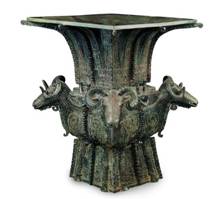
Fig. 4 The square zun vessel with four goat heads in the collection of the National Museum of China
In the Zhou Dynasty, the image of goat was found more often in the social life. The animal husbandry developed rapidly, and there appeared a great number of goats. There are fine works decorated with goat design among unearth artifacts of the Zhou Dynasty. For example, the shape and style of the bronze lei vessel with design of goat heads and six whorls of the Western Zhou Dynasty, unearthed from Zhuwa Street, Pengxian County, Sichuan Province, in 1959, reveal that the whole article was deeply influenced by the Central Plains’ culture but keeps the unique features in Ba-Shu area. The goat design at the time mainly includes three types: firstly, goat was a sacrificial offering to be presented via some vessel to ancestors and gods; secondly, the goat design shows the noble status of its owner; thirdly, goat, an animal for religious worship, was endowed with such meaning as auspiciousness and good fortune.
During the Western and Eastern Han Dynasties, there were a large number of artifacts on the subject of goat, and they were made from various materials and in great varieties. As an auspicious symbol, they were mainly unearthed from the Han tombs. Many of them bear characters for “goat”, “auspicious goat” and “highly auspicious goat”.
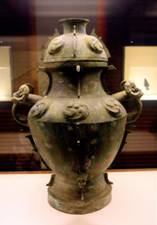
Fig. 5 Bronze lei vessel with design of goat heads and six whorls
In the Han Dynasty, goat could not only provide meat for people to eat, but also drive carriages. In May 1973, a painting of goat-drawn carriage was found in the tomb containing stone reliefs dating from the first year of Yuanjia period in Cangshan, Shandong Province. The goats in the painting are tall and muscular, drawing a carriage behind another horse-drawn carriage. This painting provides a trustworthy reference for studies on goat-drawn carriages and carriage etiquette system of the Han Dynasty.
During the Six Dynasties period, celadon became thriving. The celadon water dropper shaped like a crouching goat of the Eastern Jin Dynasty was unearthed from Xiangshan of Nanjing, Jiangsu Province. The goat figurines made in the Northern Dynasties period were also very common. Pottery goat figurines were found in tombs of the Northern Wei and Northern Qi dynasties in Hebei and Inner Mongolia. The tri-colored goats unearthed from the Tang tomb in Yanshi, Henan Province, together with the tri-colored horses and camels of the Tang Dynasty, are masterpieces of ancient Chinese craftwork.
Goat was favored by ancient people for the following reasons. Firstly, they would associate it with kindness and benevolence. After a lamb is born, it has the grace to kneel to suck, and ancient people regarded it as a kind animal, and made it an example of filial piety. Secondly, ancient people believed it was gentle and virtuous and would compare one’s virtue to a lamb. Xiezhi, a unicorn beast in legend, was also thought to be related to goat and be capable of telling the innocent from the guilty. For ordinary people, goat has been widely believed to be a symbol of “auspiciousness”.
In March 1974, a person from Lijia Village, Koudian, Yanshi, Henan Province, stumbled across an ancient hoard when he dug pits to plant trees. Upon receiving the report by the villager, the Yanshi County Cultural Heritage Management Committee immediately sent staff to the site. Archaeologists found a gilded bronze zun vessel with a lid in the hoard, and this vessel contains a total of 48 small objects and models made of gilded bronze or bronze which included this bronze galloping goat.
The bronze goat in a galloping gesture raises its head and perks up its neck, with two eyes looking forward. Its two horns arch forward and downward (Fig. 1). The outline of the head is visible, showing the eyes and eyebrows. The mouth is made into a round hole (Fig. 2). The body is plump, and the four limbs are stretching out in a powerful way: the front right limb in the air, the rear right limb and the front left limb forming an arch, and the hooves of the rear left limb touching the ground. The short tail sticks straight up. The whole design is vivid and lifelike, making viewers feel as if it were flying, and reflecting the realistic style of the Western and Eastern Han Dynasties.
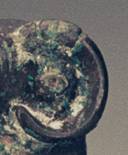
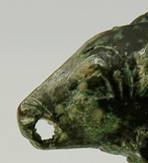
Fig. 1 Curled horn of the bronze galloping goat
Fig. 2 Detail of the head of the bronze galloping goat
Major parts on the surface of the bronze galloping sheep are blackish brown, and in some parts the brown spots are obvious. On both sides there is a small amount of bronze rust. The whole article measures 14 centimeters in length, 7 centimeters in height and 300 grams in weight. According to the excavation report, the bronze galloping goat was an artifact of the Eastern Han Dynasty. Originally its surface was gilded and the overall body should be golden yellow. Now the whole coating has been peeled off. Featuring a vivid animal shape and exquisite carving technique, it is regarded as a masterpiece of the Han vessel model, which provides abundant clues for studies on the auspicious culture and the metallurgy and casting technique of the Han Dynasty.
